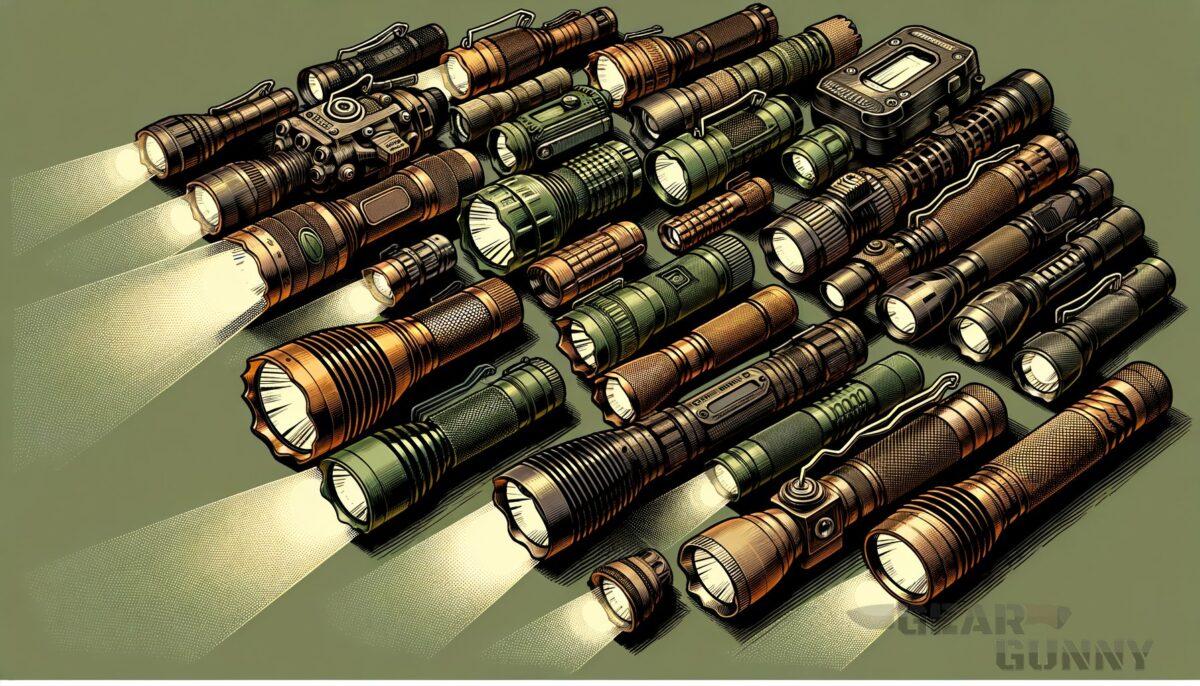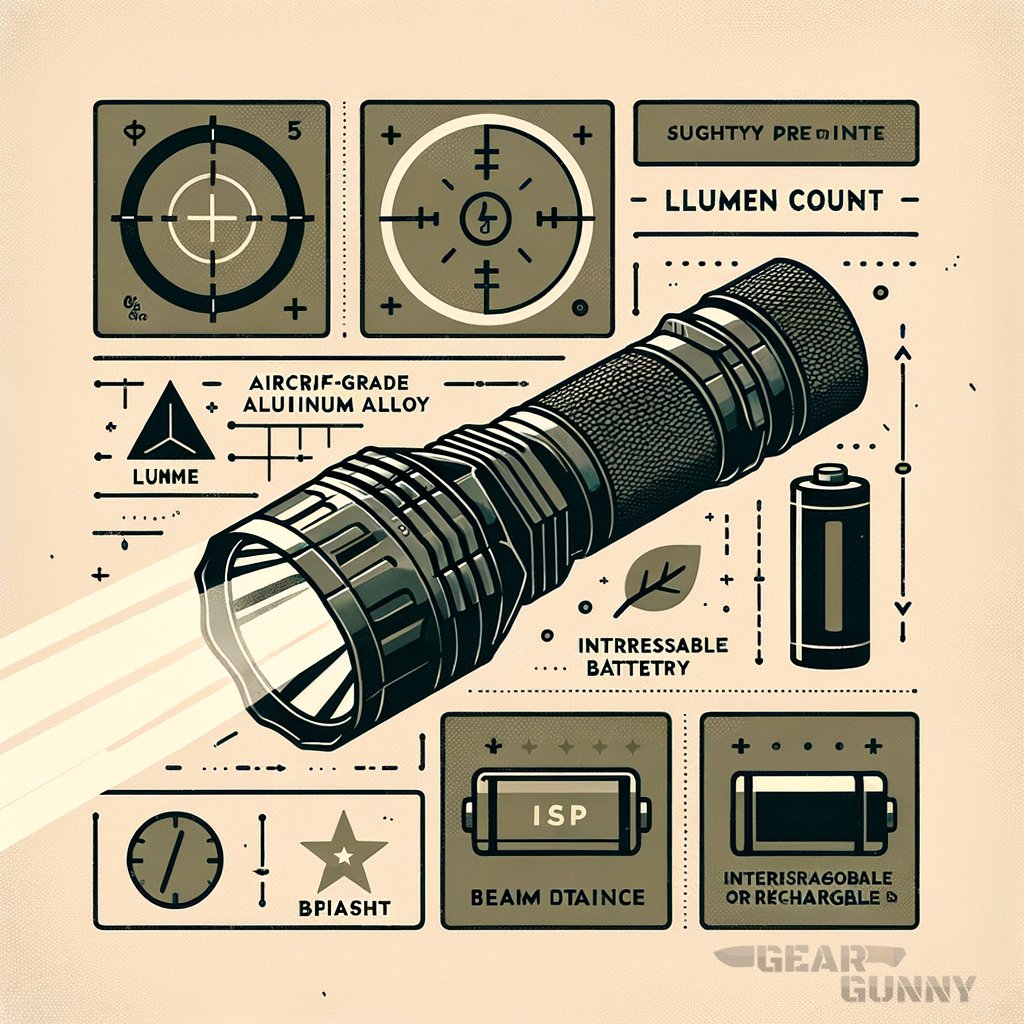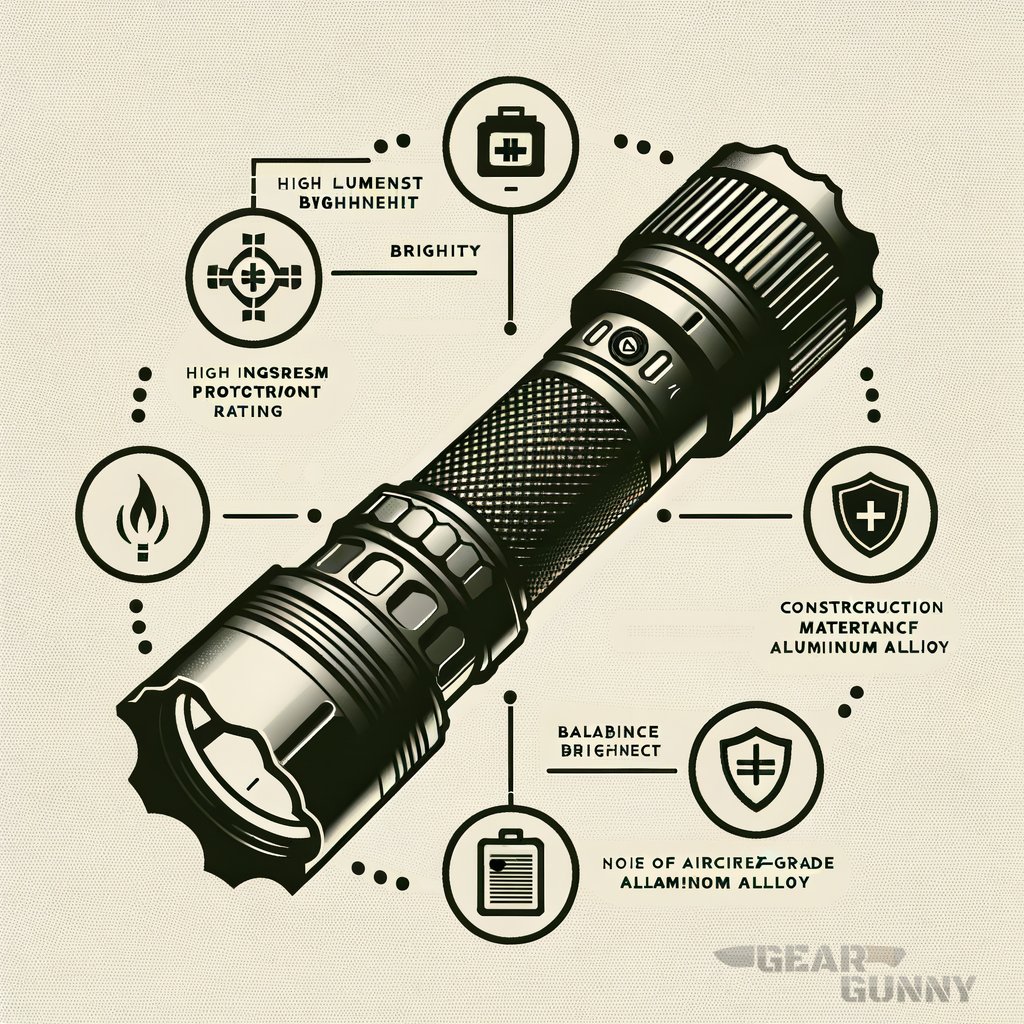Are you ready to light up the night with a tactical advantage? Whether you’re partaking in a late-night airsoft match or just need a reliable light source in the field, knowing how to pick a military-grade flashlight can mean the difference between success and fumbling in the dark. Learn how to select the flashlight that meets the specs of what’s carried into battle and discover why choosing the right gear can be as vital as the mission itself.
We’ll cover the essentials you need to know about military flashlights in this post.
Key takeaways
- Durability and performance are paramount when selecting a military-grade flashlight.
- Consider lumens, beam distance, and battery life for optimal flashlight performance.
- Maintenance and proper usage extend the life of your tactical flashlight.
Comprehensive guide to selecting military-grade flashlights
When you’re in the market for a military-grade flashlight, there are key features to consider before you make your selection.

Durability is paramount; you need a light that can withstand rough handling and extreme conditions. Look for a flashlight with a high ingress protection rating (IP), which indicates a strong resistance to dust and water. Plus, the construction material matters – typically, aircraft-grade aluminum alloy is the go-to due to its strength-to-weight ratio.
The performance of a flashlight is also critical. That means looking at lumens, which measure light output. A higher lumen count usually translates into a brighter light, but you’ll want to strike a balance between brightness and battery life.
Also, consider the beam distance and whether it offers variable modes for different scenarios.
Lastly, consider the flashlight’s size, weight, and battery type. You want something compact yet powerful, easy to carry without weighing you down. Battery choice might come down to a preference between disposable or rechargeable options, each with their own set of pros and cons in terms of longevity and convenience.
Here’s why it’s important to make the right choice:
- Weight and size affect portability
- Durability ensures reliability in harsh environments
- Brightness and battery life balance performance needs
- Beam distance can impact tactical advantage
Be sure to also check out the essentials listed in this comprehensive guide to selecting the best tactical gloves for those nighttime operations.
Holding a flashlight that’s been through the wringer without so much as a flicker in its beam can give you a big boost of confidence. Personally, I’m not an electrical engineer or a gear manufacturer, but I’ve seen my share of gear fail when you least expect it. That’s why I lean heavily on real-world reviews and field experiences from fellow grunts.
I remember this one time, a buddy told me about a night patrol gone sideways. His flashlight decided to take a permanent vacation right when he needed it most. If there’s one thing military life teaches you, it’s that Murphy’s Law is a real pain in the tailpipe.
That scene from “Jurassic Park” where the power cuts out and all you’ve got is the tremble-inducing T-rex growl in pitch-black darkness? Yeah, that’s the kind of unease you want to avoid. So do your homework, and maybe check out some insights on Archibald Henderson, a fellow who knew something about reliability and readiness.
5.11 Rush 24 Tactical Backpack

5.11 Rush 24 Tactical Backpack
Why military-grade flashlights are essential
Military-grade flashlights aren’t just for show; they’re built to endure and perform under the most strenuous conditions. A robust flashlight is necessary not only for visibility but also for tactical communication and emergency signaling.
Top-tier illumination can make or break a mission. Look for a high lumen output, necessary for both disorienting foes and navigating dark terrain. However, lumens aren’t the whole story—beam quality and pattern are just as crucial.
A robust flashlight is necessary not only for visibility but also for tactical communication and emergency signaling. High-performance lighting can provide tactical advantages and versatility with features such as adjustable modes and strobe functions.
A focused beam allows for distance spotting, while a flood beam can illuminate a larger area at close range. Considering your environment and tactical needs will guide your decision.
For further insights on vital field gear, explore the durable options for best tactical belts that can stand up to the rigors of the field.
Key features to look for
When selecting your flashlight, prioritize these vital specs:

- Durability and construction material
- Water and impact resistance
- Battery type and life
- Beam distance and pattern
- Adjustable modes for flexibility
- Size, weight, and ease of carry
Stay prepped for any scenario by also choosing the best boots for tactical use that can keep pace with the most demanding situations.
How to gauge flashlight performance
It’s not just about picking up any light—performance is a deal-maker or breaker in the selection of a military-grade flashlight.
- Lumens for brightness levels
- Beam distance for reach
- Runtime for operational longevity
Understanding how these factors play together helps you select the light that won’t let you down when the chips are down.
More considerations
Once you’ve got the basics down, ponder over these more aspects:
- Weight and portability for on-the-go needs
- Attachment options, such as clips or mounts
- Accessibility, like tail-switch operation for one-handed use
- Rechargeable vs. disposable batteries for long missions or patrols
- Strobe or SOS functions for emergency situations
Selecting a flashlight goes hand in hand with picking the correct body armor to ensure you’re fully equipped. Find out if body armor can stop a knife to stay safe in close-quarters confrontations.
Flashlight maintenance and care
Good maintenance can extend your flashlight’s life and reliability. Keep these tips in hand:
- Regular battery checks and replacements
- Cleaning and lubricating threads and O-rings
- Inspecting for damage and wear
Just as a flashlight needs care, so do your boots. Learn about what a boot jack entails to keep your gear in tip-top shape.

Specialty flashlights for unique scenarios
Sometimes, a general tactical flashlight won’t cut it. Special ops or unique situations might call for lights with infrared or UV capabilities. Consider your mission profile to determine if these specialty tools are necessary for your loadout.
Consider specialty features that complement standard tactical functions. Night vision compatibility, for example, can be a game-changer during covert operations.
Data on military-grade flashlights
When dissecting the features of military-grade flashlights, it’s crucial to compare different models side by side. Below is a table summarizing key specs commonly sought after in tactical flashlights.
| Lumens | Battery Life | Beam Distance | Water Resistance |
|---|---|---|---|
| 400-6000 | 1-100 hours | 100-500 meters | IPX4 – IPX8 |
| 500-1200 | 20-80 hours | 200-800 meters | IPX5 – IPX8 |
Lumens reflect potential brightness, battery life showcases endurance, beam distance indicates the area coverage, and water resistance level represents the resilience against environmental factors.
More military-grade flashlight tips
When you’ve got a solid military-grade flashlight, these extra tips will ensure you maximize its potential and maintain it properly for prolonged use. Let’s amplify that tactical advantage with some more pointers.
- Conduct regular maintenance, including battery replacements and cleanliness.
- Familiarize yourself with the flashlight’s functions and practice using them in the dark.
- When not in use, store the flashlight in a dry and temperate place to prevent damage.
- Test your flashlight in different environments to understand how various conditions affect its performance.
- Pair your flashlight with compatible accessories, such as holsters or mounts, for a customized setup.
Understanding the nuances of tactical gear is essential; check out what ‘ate up’ means in military slang to get a grasp on common terms and how your gear choices might be critiqued.
Remember, a flashlight is as much about seeing as being seen. Balance the use of light for navigation and communication with the need for concealment when the situation requires stealth.
| Dos | Don’ts |
|---|---|
| Do keep spare batteries on hand. | Don’t leave batteries in the flashlight unused for extended periods. |
| Do check the watertight seals regularly. | Don’t ignore signs of wear and corrosion. |
| Do practice using the flashlight in stress scenarios. | Don’t forget to clean the lens for optimal performance. |
Advantages and disadvantages of using military-grade flashlights
In the vast world of tactical equipment, each piece of gear brings its own set of pros and cons to the table—including flashlights. Here’s an exploration of the benefits and potential drawbacks of using military-grade flashlights.
Advantages
- Superior durability and reliability in extreme conditions
- High-performance lighting that can provide tactical advantages
- Versatile with features such as adjustable modes and strobe functions
- Usually designed for easy attachment to equipment and weapons
Disadvantages
- May be heavier and bulkier than civilian models
- Tend to be more expensive due to advanced features and durability
- Can be overkill for everyday use, where simpler models would suffice
- Specialized battery types can be harder to find and replace in non-military settings
Choosing the right flashlight may affect not only visibility but overall effectiveness in the field, so weigh these factors accordingly.
If you are a visual learner, check out this video titled ‘How to Choose a Flashlight’
Frequently asked questions (FAQ)
Can you adjust the brightness of military-grade flashlights?
Yes, most military-grade flashlights offer adjustable brightness levels, allowing you to select the appropriate level of illumination for your needs. This feature can also help conserve battery life when full brightness isn’t necessary.
Are military-grade flashlights only available to military personnel?
No, military-grade flashlights are available to the public and can be purchased by civilians. They are popular among outdoor enthusiasts, first responders, and those who require durable and reliable lighting solutions.
How important is the beam distance in a military-grade flashlight?
The beam distance is quite important as it determines how far the light will reach, allowing you to identify distant objects or threats. It is a critical factor for tasks that require long-range visibility, such as search and rescue or perimeter security.
Final thoughts
In the realm of tactical gear, the choice of a military-grade flashlight stands as a significant decision, not just for brightness, but for reliability and functionality in critical situations. Remember, the flashlight you choose will be a partner in every dark corner and every night mission, so invest wisely in a model that checks all the right boxes.
Have you ever had a flashlight fail at a crucial moment? Did I cover everything you wanted to know? Let me know in the comments section below — I read and reply to every comment.
If you found this article helpful, share it with a friend, and check out my full blog for more tips and tricks on tactical and military gear. Thanks for reading, and stay on target!















